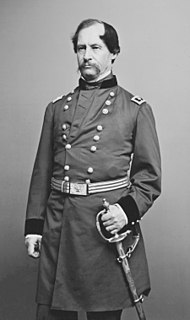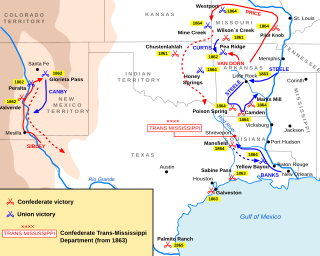Camp Hunter was established in June 1862 or a bit earlier at what is now Baxter Springs, Kansas. It was established by Union troops. At the same time Indian Home Guard regiments established a camp nearby on Little Five Mile Creek. [1]

Baxter Springs is a city in Cherokee County, Kansas, United States, and located along Spring River. As of the 2010 census, the city population was 4,238; it is the most populous city of Cherokee County.

During the American Civil War, the Union Army referred to the United States Army, the land force that fought to preserve the Union of the collective states. Also known as the Federal Army, it proved essential to the preservation of the United States of America as a working, viable republic.
The white soldiers' camp was named after Gen. David Hunter. It was built along the south crest of the Spring Creek valley. The combined number of troops in both camps was about 6,000 men, according to Hugh Thompson, who was stationed as a scout in the area in June 1862.

David Hunter was a Union general during the American Civil War. He achieved fame by his unauthorized 1862 order emancipating slaves in three Southern states, for his leadership of United States troops during the Valley Campaigns of 1864, and as the president of the military commission trying the conspirators involved with the assassination of U.S. President Abraham Lincoln.
The Army had three reasons for the establishment of the two camps. The first was to help escort wagon trains south into Indian Territory, where Indians loyal to the Confederacy attacked Union wagon trains. A second use for the camps was to be a place to send tired cavalry horses. The area west of the camps had much grass. The soldiers from the camps were needed to guard the horses.

A wagon train is a group of wagons traveling together. Before the extensive use of military vehicles, baggage trains followed an army with supplies and ammunition.

As general terms, Indian Territory, the Indian Territories, or Indian country describe an evolving land area set aside by the United States Government for the relocation of Native Americans who held aboriginal title to their land. In general, the tribes ceded land they occupied in exchange for land grants in 1803. The concept of an Indian Territory was an outcome of the 18th- and 19th-century policy of Indian removal. After the Civil War (1861–1865), the policy of the government was one of assimilation.
A third reason for the establishment of the camps was to oppose the bushwhackers and Confederate Indians who roamed through the area. The major guerrilla group was under the command of Capt. Thomas R. Livingston. [2]
As soon as the two camps were established, the Union troops took action to eliminate Livingston's guerrillas. Livingston, with about twenty-five men, had established a camp two miles northeast of Camp Hunter. The combined Union forces, under the direction of Col. Charles Doubleday, overran Livingston's camp, capturing many supplies and horses. [3]
Livingston was not to be eliminated, however. Further attempts to destroy his force or capture it resulted in frustration. The Union troops from the two camps, and other Union troops nearby, repeatedly forced the guerrillas to scatter. Instead of being able to round them up, however, they found the guerrillas would simply disappear, not to be found until they decided to attack Union troops. After the War it was discovered the guerrillas had established a well concealed camp (Livingston's Hideout) 5½ miles east of Camp Hunter and just inside the Kansas border with Missouri. [4]
Livingston's Hideout was most likely the only permanent Confederate military camp inside Kansas during the Civil War. It was in the very corner of southeast Kansas, in the very corner of Cherokee County, Kansas. It was about 2 miles (3.2 km) north of the border with Indian Territory and it was less than 100 feet (30 m) west of the border with Missouri. It was 5 miles (8.0 km) west of Baxter Springs, where a series of Union military posts existed from 1862 to 1863. Thomas R. Livingston became a leader of a group of Confederate guerrillas in the area, becoming first a captain and then a major. He needed locations to hide himself and his guerrillas from pursuing Union troops and this hideout suited the guerrillas well. The guerrillas sought to spy on Union forces and raiding units he found small enough to defeat.
In early September 1862 the area around Camp Hunter found itself in the path of a Confederate offensive. The 31st Texas Cavalry, under Col. Tresevant C. Hawpe, headed toward the two camps, which were quickly abandoned. He continued north and was defeated in a battle near present day Pittsburg, Kansas. After his defeat Hawpe retreated back to Camp Hunter and briefly occupied it. Possibly Livingston and Confederate Indians under Col. Stand Watie visited Camp Hunter around the same time.
From Camp Hunter, Hawpe invaded southwest Missouri, helping other Confederates in defeating Union forces in the First Battle of Newtonia on September 30. After Hawpe left, Camp Hunter was never occupied again. When Union forces returned to Baxter Springs in May 1863, they set up camp at a different site. [5]





